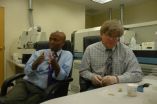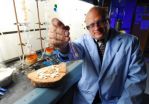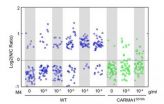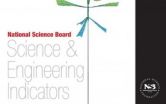(Press-News.org) Assembling the puzzles of quantum materials is, in some ways, like dipping a wire hanger into a vat of soapy water, says CIFAR (Canadian Institute for Advanced Research) Fellow Joseph Thywissen (University of Toronto).
Long before mathematical equations could explain the shapes and angles in the soap foams, mathematicians conjectured that soap films naturally found the geometry that minimized surface area, thus solving the problem of minimal surfaces. They could be created simply by blowing soap bubbles.
At the University of Toronto's Ultracold Atoms Lab, Thywissen and his team strive to answer what he calls "soap bubble" questions — deep mysteries of the enigmatic quantum materials world that simulations can help us solve. Since the electrons within quantum materials, such as superconductors, zoom far too quickly for careful observation, Thywissen's team uses ultracold gases instead, in this way simulating one quantum system with another, more easily studied, quantum system.
"Simulation gives you the answers but not the theory behind them," says Thywissen.
Thywissen's lab has revealed some of these answers in a new paper about the magnetism and diffusion of atoms in ultracold gases, published in the journal Science. The researchers optically trapped a cloud of gas a billion times colder than air in a very low-pressure vacuum.
They oriented the ultracold atoms, which behave like microscopic magnets, to make them all point in the same direction in space, then manipulated the spins with an effect that's regularly used in hospitals for MRIs, called a spin echo.
Twisting up the direction into a corkscrew pattern and then untwisting it, they measured the strength of interactions between atoms. They observed that at first the atoms did not interact, but one millisecond later they were strongly interacting and correlated.
This rapid change suggested that something was happening to alter the atoms' magnetism as the process unfolded.
"The Pauli Principle forbids identical ultracold atoms from interacting, so we knew something was scrambling the spins at a microscopic level," Thywissen says.
What was happening, the researchers learned next, was diffusion — the same process that takes place when the smell of perfume fills the air of a room, for example.
"If I open a bottle of perfume in the front of the room, it takes a little while for those particles to diffuse to the back of the room," Thywissen says. "They bump into other particles on the way, but eventually get there. You can imagine that the more particles bump into each other, the slower diffusion occurs."
Cranking up interactions to their maximum allowed level, the Toronto team tried to see how slow diffusion could be. They lowered temperature below a millionth of a degree above absolute zero. You might guess that the speed of diffusion would eventually reach zero, but instead the experiment found a lower limit to diffusion.
"Whereas cars on the freeway need to drive below the speed limit, strongly interacting spins need to diffuse above a quantum speed limit," Thywissen says.
Ultracold atoms are just one of a larger family of strongly interacting materials, that also include superconductors and magnetic materials. Thywissen is a member of the CIFAR Quantum Materials program, which is developing an understanding of these materials' novel properties. Cold atoms offer a promising way to explore the mystery of how electrons self-organize to exhibit unusual and valuable properties, such as superconductivity. Quantum materials contain mysteries that have challenged physicists for decades.
"Our measurements imply a diffusivity bound whose mathematical simplicity is exciting: it hints at a universal principle about spin transport, waiting to be uncovered," he says.
Thywissen says CIFAR's support helped make this successful experiment possible.
"CIFAR enabled me to assemble a world-class team."
INFORMATION:
The authors on the paper "Transverse Demagnetization Dynamics of a Unitary Fermi Gas," published in Science, are Alma Bardon, Scott Beattie, Chris Luciuk, Will Cairncross, Daniel Fine, Nathan Cheng, Graham Edge, Edward Taylor, Shizhong Zhang, Stefan Trotzky and Joseph Thywissen.
About CIFAR
CIFAR brings together extraordinary scholars and scientists from around the world to address questions of global importance. Based in Toronto, Canada, CIFAR is a global research organization comprising nearly 400 fellows, scholars and advisors from more than 100 institutions in 16 countries. The Institute helps to resolve the world's major challenges by contributing transformative knowledge, acting as a catalyst for change, and developing a new generation of research leaders. Established in 1982, CIFAR partners with the Government of Canada, provincial governments, individuals, foundations, corporations and research institutions to extend our impact in the world.
CIFAR's program in Quantum Materials invents and explores materials whose novel and unusual electronic properties, like superconductivity, could revolutionize technology.
Contacts:
Lindsay Jolivet
Writer & Media Relations Specialist
Canadian Institute for Advanced Research
lindsay.jolivet@cifar.ca
416-971-4876
Joseph Thywissen
University of Toronto
jht@physics.utoronto.ca
416-978-2941 (Office)
Quantum simulator gives clues about magnetism
Paper in Science reveals new clues about how ultracold atoms interact, including how they can switch from non-interacting to strongly interacting in only a millisecond
2014-05-15
ELSE PRESS RELEASES FROM THIS DATE:
UNM plays major role in establishing link between ancient and modern Native-Americans
2014-05-15
Her name is Naia, and for thousands and thousands of years, the skeleton of this young woman was buried underwater in an elaborate cave system in the Yucatan Peninsula after she had apparently fallen into what was then a dry deep pit.
Now, a team of researchers, including Professor Yemane Asmerom and Research Scientist Victor Polyak at the University of New Mexico's Department of Earth and Planetary Sciences, have accurately determined the age of the oldest-known, well-preserved human skeleton. Naia was one of the earliest inhabitants of the Americas and has helped resolve ...
Making money from lignin: Roadmap shows how to improve lignocellulosic biofuel biorefining
2014-05-15
When making cellulosic ethanol from plants, one problem is what to do with a woody agricultural waste product called lignin. The old adage in the pulp industry has been that one can make anything from lignin except money.
A new review article in the journal Science points the way toward a future where lignin is transformed from a waste product into valuable materials such as low-cost carbon fiber for cars or bio-based plastics. Using lignin in this way would create new markets for the forest products industry and make ethanol-to-fuel conversion more cost-effective.
"We've ...
UH researchers find definitive evidence of how zeolites grow
2014-05-15
Researchers have found the first definitive evidence of how silicalite-1 (MFI type) zeolites grow, showing that growth is a concerted process involving both the attachment of nanoparticles and the addition of molecules.
Both processes appear to happen simultaneously, said Jeffrey Rimer, an engineering professor at the University of Houston and lead author of a paper published Thursday in the journal Science.
He said a second component to the research could have even more lasting impact. He and researcher Alexandra I. Lupulescu used a new technique allowing them to view ...
Anti-craving drug and counseling lower alcohol harm in homeless, without sobriety demands
2014-05-15
Chronically homeless, alcohol-dependent individuals might benefit from a new intervention that does not require them to stop or even reduce drinking, according to the results of a preliminary study in Seattle.
Participants in the 12-week pilot program received monthly injections of an anti-craving medication, extended-release naltrexone. They also met regularly with study physicians to set their own goals for treatment and to learn to be safer in their use of alcohol.
"Abstinence-based alcohol treatment has not been effective for or desirable to many homeless people ...
UTHealth research: Children of parents in technical jobs at higher risk for autism
2014-05-15
HOUSTON – (May 15, 2014) – Children of fathers who are in technical occupations are more likely to have an autism spectrum disorder, according to researchers at The University of Texas Health Science Center at Houston (UTHealth).
The findings will be presented Friday at the International Meeting for Autism Research in Atlanta.
During participation in the LoneStar LEND program, first author Aisha S. Dickerson, Ph.D., a researcher at UTHealth's Center for Clinical and Translational Sciences, used the United States government's Standard Occupational Classification system. ...
B cells produce antibodies 'when danger calls, but not when it whispers'
2014-05-15
The immune system's B cells protect us from disease by producing antibodies, or "smart bullets," that specifically target invaders such as pathogens and viruses while leaving harmless molecules alone. But how do B cells determine whether a threat is real and whether to start producing these weapons?
An international team of life scientists shows in the May 16 issue of the journal Science how and why these cells respond only to true threats.
"It is critical for B cells to respond either fully or not at all. Anything in between causes disease," said the study's senior ...
Researchers show emissions from forests influence very first stage of cloud formation
2014-05-15
PITTSBURGH—Clouds play a critical role in Earth's climate. Clouds also are the largest source of uncertainty in present climate models, according to the latest report of the Intergovernmental Panel on Climate Change. Much of the uncertainty surrounding clouds' effect on climate stems from the complexity of cloud formation.
New research from scientists at the CLOUD (Cosmics Leaving OUtdoor Droplets) experiment at CERN, including Carnegie Mellon University's Neil Donahue, sheds light on new-particle formation — the very first step of cloud formation and a critical component ...
New data show how states are doing in science
2014-05-15
The newly updated, online, interactive state data tool allows policymakers, educators and other users to discern trends in education, science and research in each of the 50 states. This free resource supplements the state data in the 2014 Science and Engineering Indicators report, the premier source of information and analysis of the nation's position in science and engineering education and research. The biennial report is published by the National Science Board, the policy making body of the National Science Foundation (NSF).
The tool features 59 state indicators of ...
UH Case Medical Center neurosurgeon uses depth electrodes for speech mapping
2014-05-15
CLEVELAND -- At the 2014 American Association of Neurological Surgeons Annual Meeting, neurosurgical researchers from University Hospitals (UH) Case Medical Center presented results from a small study looking at deep brain electrode implantation as a possible alternative to the traditional WADA test used prior to epilepsy surgery.
The WADA test is considered the gold standard for identifying the side of the brain for speech dominance. In the WADA test, doctors put one half of a patient's brain to sleep for a few minutes using medication and then have the patient read ...
Study: Targeted funding can help address inequities in early child care programs
2014-05-15
CORVALLIS, Ore. – The quality of early child care and education programs is influenced both by funding and by the characteristics of the communities in which the programs operate, new research from Oregon State University shows.
The findings indicate that law- and policy-makers may need to consider the demographics of communities when making funding decisions about early childhood programs, said Bridget Hatfield, an assistant professor in OSU's College of Public Health and Human Sciences.
That's especially important now because many states, including Oregon, are adopting ...
LAST 30 PRESS RELEASES:
Numbers in our sights affect how we perceive space
SIMJ announces global collaborative book project in commemoration of its 75th anniversary
Air pollution exposure and birth weight
Obstructive sleep apnea risk and mental health conditions among older adults
How talking slows eye movements behind the wheel
The Ceramic Society of Japan’s Oxoate Ceramics Research Association launches new international book project
Heart-brain connection: international study reveals the role of the vagus nerve in keeping the heart young
Researchers identify Rb1 as a predictive biomarker for a new therapeutic strategy in some breast cancers
Survey reveals ethical gaps slowing AI adoption in pediatric surgery
Stimulant ADHD medications work differently than thought
AI overestimates how smart people are, according to HSE economists
HSE researchers create genome-wide map of quadruplexes
Scientists boost cell "powerhouses" to burn more calories
Automatic label checking: The missing step in making reliable medical AI
Low daily alcohol intake linked to 50% heightened mouth cancer risk in India
American Meteorological Society announces Rick Spinrad as 2026 President-Elect
Biomass-based carbon capture spotlighted in newly released global climate webinar recording
Illuminating invisible nano pollutants: advanced bioimaging tracks the full journey of emerging nanoscale contaminants in living systems
How does age affect recovery from spinal cord injury?
Novel AI tool offers prognosis for patients with head and neck cancer
Fathers’ microplastic exposure tied to their children’s metabolic problems
Research validates laboratory model for studying high-grade serous ovarian cancer
SIR 2026 delivers transformative breakthroughs in minimally invasive medicine to improve patient care
Stem Cell Reports most downloaded papers of 2025 highlight the breadth and impact of stem cell research
Oxford-led study estimates NHS spends around 3% of its primary and secondary care budget on the health impacts of heat and cold in England
A researcher’s long quest leads to a smart composite breakthrough
Urban wild bees act as “microbial sensors” of city health.
New study finds where you live affects recovery after a hip fracture
Forecasting the impact of fully automated vehicle adoption on US road traffic injuries
Alcohol-related hospitalizations from 2016 to 2022
[Press-News.org] Quantum simulator gives clues about magnetismPaper in Science reveals new clues about how ultracold atoms interact, including how they can switch from non-interacting to strongly interacting in only a millisecond








